Composting is an eco-friendly way to recycle organic waste and turn it into nutrient-rich soil for your garden.
It’s a great way to reduce the amount of waste in landfills, which in turn, reduces greenhouse gas emissions.
As a gardener, this can also help to improve your soil structure, water retention, and nutrient availability, leading to healthier plants and higher yields.
Other materials like corn cobs can be used for composting. However, cardboard is a great carbon source for your compost pile and can help balance the nitrogen-rich “green” materials like food scraps and grass clippings.
Shredding cardboard for composting is an easy way to recycle and turn it into compost for your garden because, from my experience in making compost with cardboard, cutting them one after the other is stressful.
In this blog post, I will discuss the various methods of shredding, the benefits of using shredded cardboard in compost, and how to incorporate it into their composting routine properly.
7 Ways to Shred Cardboard for Compost
1. Box Cutter
This method involves using a sharp box cutter to cut the cardboard into smaller pieces. If you’re working with corrugated cardboard, you can use the wavy lines that give the cardboard rigidity to slice through the layers more easily.
For smoother cutting, you can dampen the cardboard slightly. The moisture softens the fibers and makes them more pliable, helping the blade glide through.
Apply moderate pressure to the box cutter and follow the lines you want to cut. With a bit of effort, the blade should slice through the cardboard.
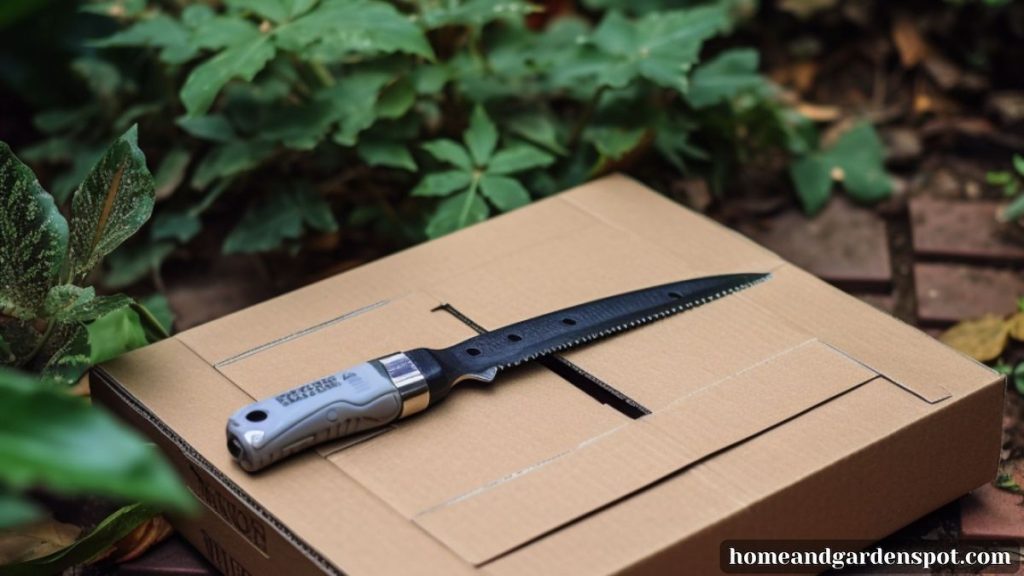
2. Power Tools
Power tools such as electric cutters, band saws, circular saws, and small chainsaws are excellent choices for efficient cutting.
These tools can cut through multiple layers of cardboard at once, which makes them ideal for larger shredding tasks.
However, safety is crucial when using power tools. Always wear appropriate protective gear, including safety glasses or goggles, to shield your eyes from debris and a face mask to prevent inhaling dust.
Position the cardboard properly on a stable surface before activating the tool. Follow the manufacturer’s instructions for the specific tool you’re using to ensure safe and effective cutting.
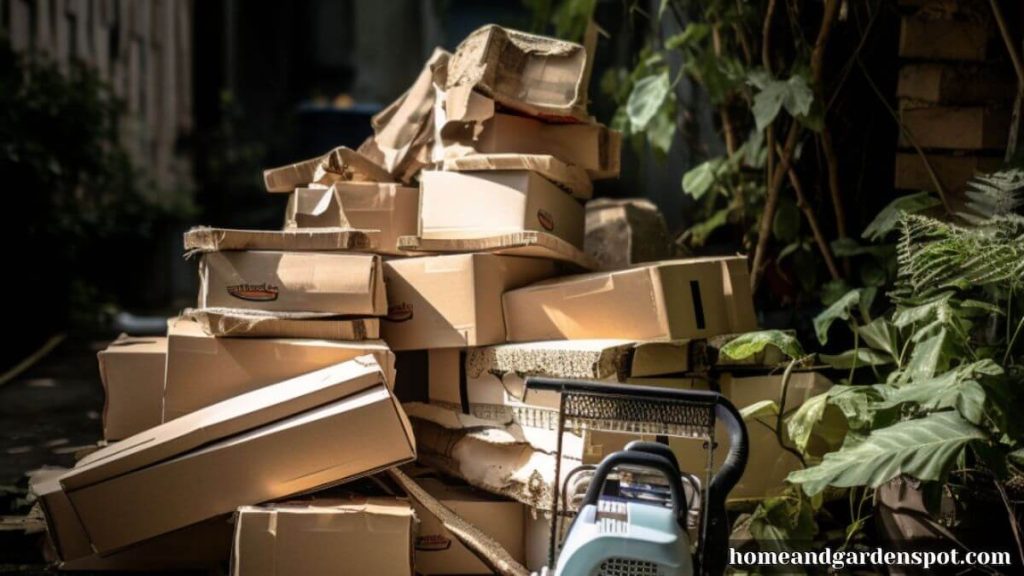
3. Heavy-Duty Office Shredder
Using a heavy-duty office shredder designed to handle thicker materials is straightforward. Break down the cardboard into manageable pieces within the shredder’s feed opening.
Insert the pieces individually, allowing the shredder’s cutting mechanism to process them. Go for a shredder with a higher sheet capacity to handle thicker cardboard.
Longer run times in these shredders ensure uninterrupted shredding sessions, particularly useful when dealing with larger quantities.

4. Micro-Cut vs. Cross-Cut Shredders
When choosing between micro-cut and cross-cut shredders, consider the result you want for composting.
Cross-cut shredders produce larger shreds, which contribute to better compost structure. If your cardboard pieces are too large to fit the shredder’s feed opening, you can use tools like electric or box cutters to prepare them for shredding.
Cut the cardboard into smaller sections that fit the shredder while ensuring the blade can handle the thickness.
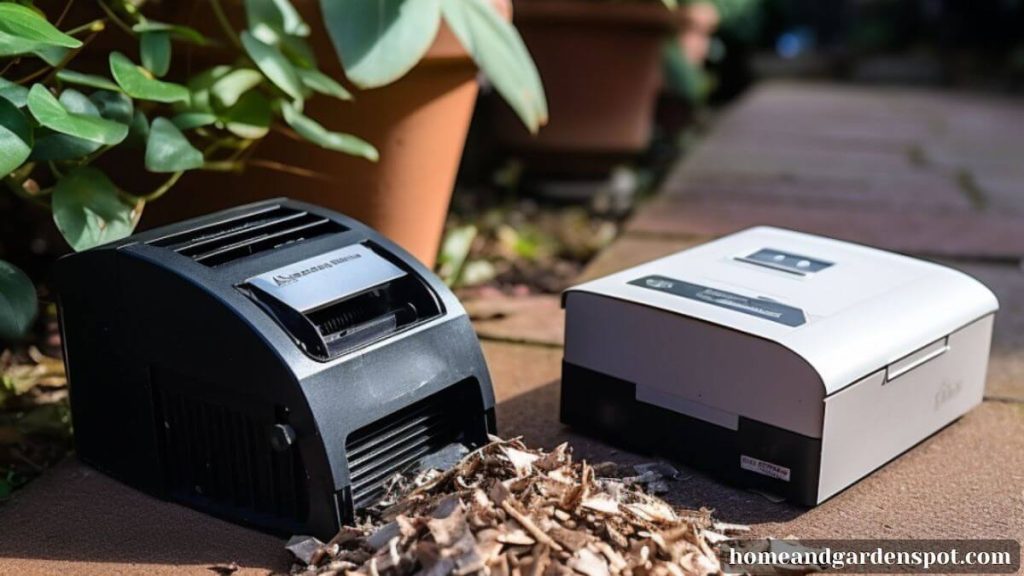
5. Chipper Shredder
Chipper shredders are heavy-duty machines originally designed for garden debris. To use them for shredding cardboard, ensure the material is dry to prevent clogs.
Remove any metal parts like staples before feeding the cardboard into the machine. The chipper shredder’s powerful blades will break down the cardboard into smaller pieces suitable for composting.
Always follow the manufacturer’s guidelines for operating the chipper shredder safely.
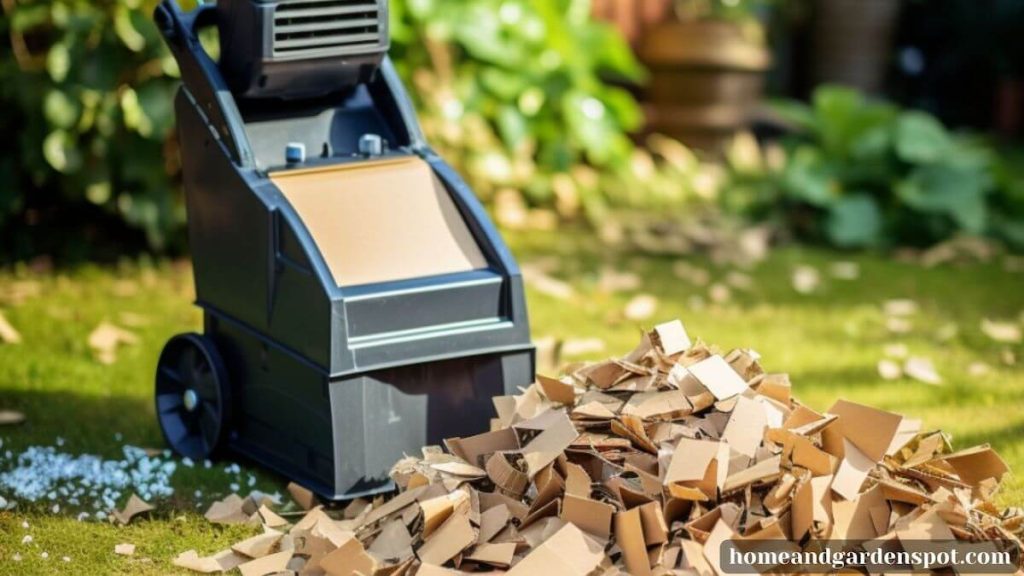
6. Shredding with Water
Soaking cardboard in water is a technique that softens the material and makes it easier to shred.
- Allow the cardboard to sit in water through rain exposure or water immersion. Wet cardboard becomes more pliable and crumbles more easily.
- Once saturated, you can shred the cardboard by hand, using tools like a garden pitchfork or some cutting methods mentioned earlier.
- The softened cardboard breaks apart with less effort, facilitating the shredding process.
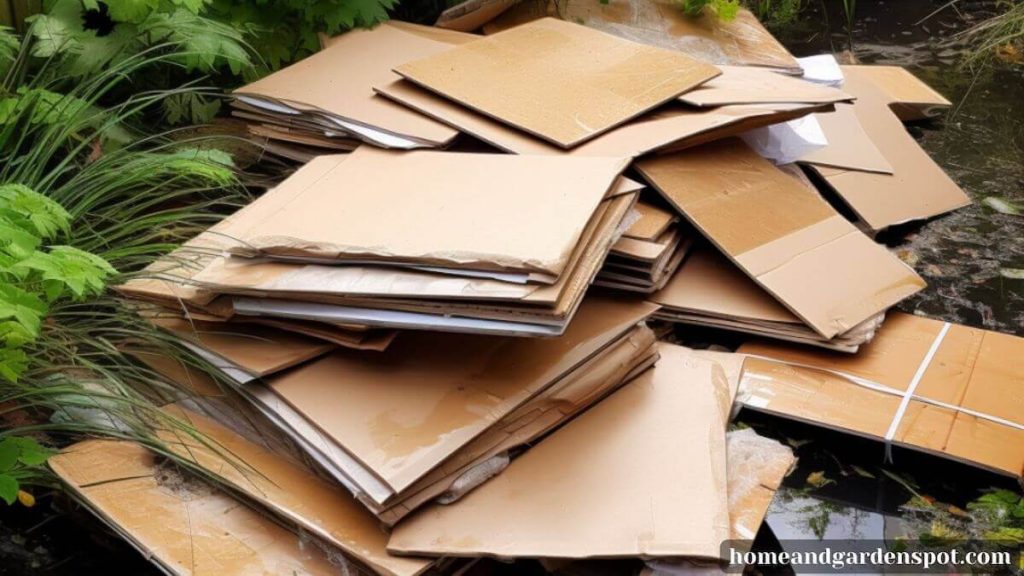
7. Rotary Paper Trimmer
A rotary paper trimmer is a cutting tool commonly used for accurately trimming paper, photographs, and other thin materials.
It has a cutting head that moves along a rotary blade, allowing precise and clean cuts. While rotary paper trimmers are not designed for heavy-duty cardboard shredding like some methods mentioned earlier, they can still be useful for smaller-scale shredding tasks.
- If you intend to use a rotary paper trimmer for shredding cardboard, remember that it’s best suited for thinner cardboard or cardstock. Here’s how you might adapt this tool for shredding:
- Cut the cardboard into narrower strips that can fit within the cutting area of the rotary paper trimmer. Ensure the cardboard is relatively thin and not too stiff.
- Align the cardboard strip within the trimming guide on the rotary paper trimmer.
- Lower the cutting head with the rotary blade and move it along the strip to create smaller pieces. Repeat this process for each strip.

How Long Does Shredded Cardboard Take to Compost?
The time it takes for shredded cardboard to decompose in a compost heap varies depending on several factors, such as the size of your compost pile, the aeration, and the ratio of materials used.
However, it generally takes 3 to 8 months for complete degradation to occur and for suitable compost to be formed.
Advantages of Using Cardboard for Composting
Cardboard is a useful addition to your compost bin, especially if you live in an area without many woody plants. Here are some benefits of using cardboard for composting:
1. Rich in Carbon
Cardboard is rich in carbon, which feeds compost microorganisms. This helps to break down waste faster and provides a nutrient source for your worms.
2. Increases Aeration within the Pile
Cardboard helps to increase aeration within the pile, which is important for the composting process. This is because it allows oxygen to circulate more freely, which helps to speed up decomposition.
3. Insulates to Retain Heat Inside the Compost
Cardboard can also help to insulate your compost pile, which helps to retain heat inside the pile. This is important because heat is necessary for the composting process.
4. Balances High Amounts of Nitrogen Ingredients
Cardboard can help to balance high amounts of nitrogen ingredients in your compost pile. This is important because too much nitrogen can cause your compost pile to become too acidic.
5. Free and Abundant “Brown” Material
Cardboard is a free and abundant “brown” material source for your compost pile. This is important because “brown” material helps balance “green” material in your compost pile.
6. Soaks Up Excessive Moisture
Cardboard can absorb excess moisture in your compost pile, which helps to prevent it from becoming too wet.
7. Excellent Bedding for Vermicomposting Systems
Cardboard makes excellent bedding for vermicomposting systems. It provides a comfortable environment for worms and other beneficial microorganisms.
8. Reduces Waste Going to the Landfill
Composting cardboard reduces the amount of waste that goes to the landfill. This is important because landfills are a major source of greenhouse gas emissions.
Can You Compost Dirty Cardboard?
Yes, you can compost dirty cardboard, but it’s important to note that the quality of your compost may be affected.
Dirty cardboard can contain contaminants such as oil, grease, or chemicals that can harm the microorganisms that break down the material.
If you decide to compost dirty cardboard, I would advise that you remove any large debris and avoid adding too much to your compost pile.
How to Compost Shredded Cardboard
1. Collect Cardboard
Begin by accumulating cardboard materials that you intend to compost. Cardboard boxes, packaging, and other paper-based products are suitable.
Ensure these items are clean and free from non-compostable plastic, tape, or glossy coatings. These non-organic elements can hinder the composting process.
2. Shred Cardboard
Once you have your cardboard collection, shred it into smaller pieces. This can be achieved using a box cutter, power tools, heavy-duty shredders, or even soaking and manually tearing it apart. Shredding increases the surface area of the cardboard, promoting faster decomposition.
3. Add to Compost Pile
Your compost pile is a dynamic ecosystem where organic materials break into nutrient-rich soil.
Alongside the shredded cardboard, introduce other compostable materials like kitchen scraps (fruit and vegetable peels, coffee grounds), yard waste (grass clippings, leaves), and additional paper products (newspaper, egg cartons).
This diversity of materials fosters a balanced and productive composting environment.
4. Mix Thoroughly
After adding the shredded cardboard and other materials, use a pitchfork or compost-turning tool to thoroughly mix the pile’s contents.
Even distribution of different materials promotes balanced decomposition and prevents the formation of clumps or compacted areas.
5. Monitor Moisture
Adequate moisture is crucial for the composting process. Your compost pile should feel like a damp sponge, not too dry or soggy.
If the pile is too dry, add water while turning to ensure even absorption. Conversely, if it’s too wet, mix in dry materials like leaves or straw to improve aeration and prevent odors.
6. Turn the Pile
Regularly turning the compost pile introduces oxygen, which is essential for the breakdown of materials by microorganisms.
Use a pitchfork to turn the pile every few weeks gently. This action helps prevent the pile from compacting and encourages even decomposition.
7. Patience for Compost
The time required for your compost to fully decompose varies based on factors such as the size of the pile, the types of materials used, the ambient temperature, and the moisture levels.
Generally, it takes several months for compost to transform into a dark, crumbly, and earthy-smelling mixture. As the compost matures, you might notice fewer recognizable materials in the mixture.
8. Use Compost
Once the composting process is complete and you’re left with a rich, dark compost, it will be used in your garden.
Apply it as a nutrient-rich soil amendment by incorporating it into garden beds, potting mixes, or around the base of plants.
The compost will enrich the soil with organic matter, improving soil structure, water retention, and nutrient availability for your plants.
Conclusion
Shredding cardboard for composting is a simple and effective way to reduce waste and create nutrient-rich soil for your garden.
Use the methods I’ve shared in this post to effectively utilize cardboard for your composting need
The simplest method involves using a box cutter, while power tools such as electric cutters, band saws, circular saws, or even small chainsaws can provide greater efficiency.
Also, invest in a heavy-duty paper shredder that can handle the task for a consistent supply of shredded cardboard.
When selecting a shredder, consider the choice between micro-cut and cross-cut options. Most composters prefer cross-cut shredders as they generate larger shreds contributing to better compost structure.
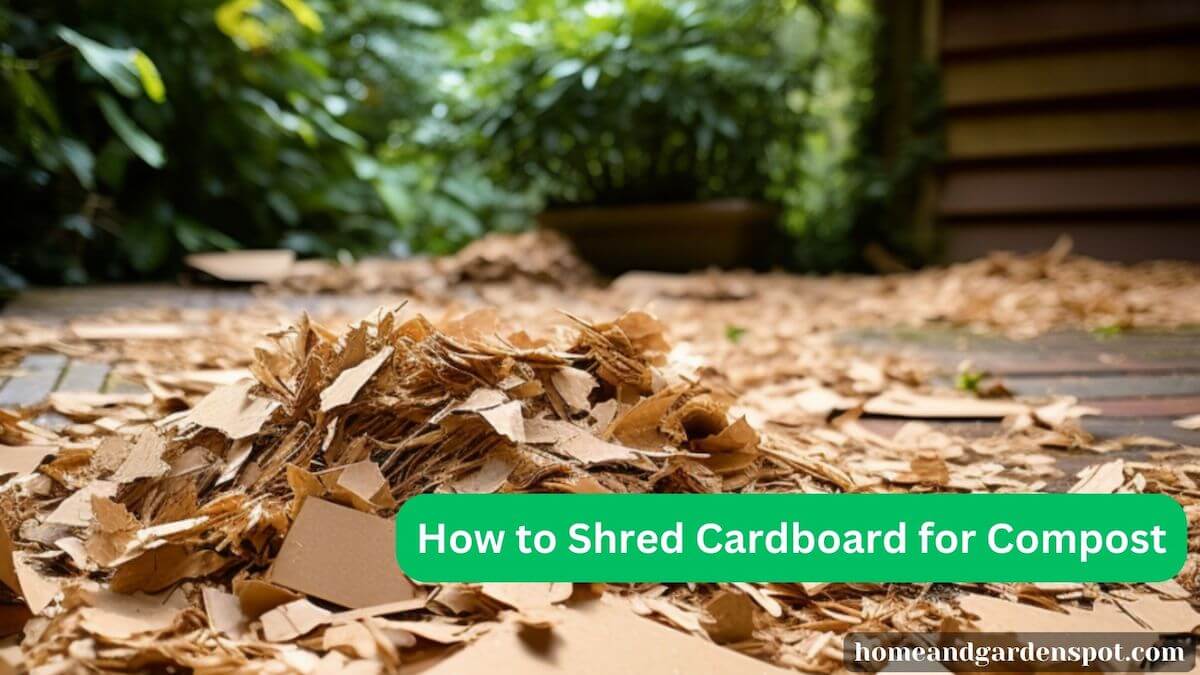
Leave a Reply